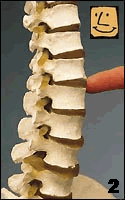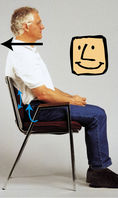|
|
| Research |
|
The Good, the Bad and Why Oregon Aero Seat Cushion Systems Are Painless:
The Story With Pictures |
"Sit up straight!" It turns out your parents were right. Sitting straight helps create a smooth lumbar curve, essential for seating comfort. But its impossible to sit correctly in conventional seating, which is why sitting is painful. Oregon Aero seat cushion systems, on the other hand, provide pain-free sitting.
Here is the story in pictures. |
Oregon Aero Painless Seating:
Proper Lumbar Curve and Pelvic Position |
| 1 |  | | | Painless Sitting! | | | Pelvis rotated forward | | | Smooth lumbar curve |
|
| 2 |
 |
| | Closeup of lumbar vertebra and disk in painless position | | | Loose, no strain or stress | | | Ideal relative surfaces of adjacent vertebrae | | | Remember: disks are naturally wedge-shaped | | | |
|
| 3 |  |
NO
MORE SLOUCH, NO MORE PAIN!
| | Shoulders
and head shift effortlessly into painless position. |
| | Smooth lumbar curve | | | Shown
with SoftSeat® Portable Seat Cushion, but same painless seating
occurs with all Oregon Aero® Seating Systems. |
| | |
| | | Oregon
Aero complies with all applicable FAA regulations by supplying
FAA-approved seating and other parts to the public and OEMs. The Oregon
Aero Engineering
Department has an FAA “Seat” Designated Engineering Representative
(DER) on staff to support our customers. |
| Why Are Conventional Seats Painful? |
| 1 |  | Our body weight lands on the pelvis ischial tuberosity (the "sits bones") but the center of gravity of the upper body is behind the sits bones SO |
| 2 |  | The pelvis is rotated back, down and around the sits bones. This flattens the lumbar spine and compresses the anterior (front) of the disks at the lumbar spine (see two closeup photos), causing pain. |
| 3 |  | | | Anterior surfaces of wedge-shaped lumbar disk compressed to parallel position by pelvic rotation back and down | | | Undesirable, painful position | | | Produces low back strain, pain | | | Remember: disks are naturally wedge-shaped | | | |
|
| 4 |  | | | Using cushion to push on the lumbar doesnt overcome gravity! | | | Pelvis tipped back and down | | | Anterior surfaces of wedge-shaped lumbar disk compressed to parallel position | | | Undesirable relative surfaces of adjacent vertebrae | | | Painful position | | | Produces low back strain, pain | | | |
|
| 5 |  | Our instinctive response is to try and place pressure under the pelvis by slouching or using some kind of lumbar support, but this results in a complete curvature of the spine, compressing all of the disks up to the neck. Look closely at the spine photo and at Mike slouched in his office chair. Look (and feel) familiar?
Note the top of the spine is rotated forward. This is felt as a tendency for the head and chest to fall forward and compress the diaphragm area of the upper abdomen. So with great effort we try to sit straight and pull our shoulders back. All of this is our clue that the pelvis is rotated back and down and that our back will hurt eventually, no matter what we do with lumbar cushions! | | 6 |  |
| Oregon
Aero designs all our cushion products in order to provide
a gentle rotation of the pelvis. This rotation restores the lumbar
curve and
removes the compression strain from the spinal disks. |
|
| |
|
| Web design by Kramer Communications, Inc. |
|